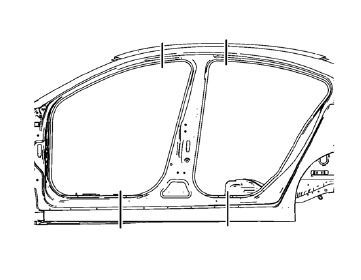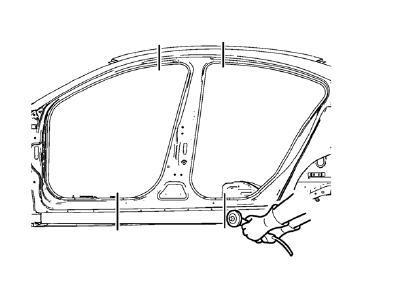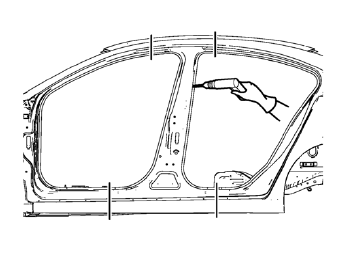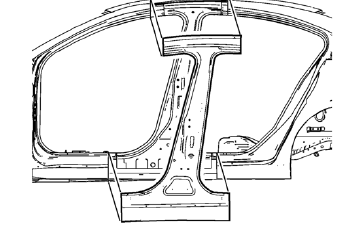Chevrolet Cruze Repair Manual: Removal Procedure
Warning: Refer to Approved Equipment for Collision Repair Warning in the Preface section.
Warning: Refer to Collision Sectioning Warning in the Preface section.
Warning: Refer to Glass and Sheet Metal Handling Warning in the Preface section.
- Disable the SIR System. Refer to SIR Disabling and Enabling.
- Disconnect the negative battery cable. Refer to Battery Negative Cable Disconnection and Connection.
- Remove all related panels and components
- Visually inspect the damage. Repair as much of the damage as possible.
- Remove the sealers and anti-corrosion materials from the repair area, as necessary. Refer to Anti-Corrosion Treatment and Repair

- Create cut lines on the body lock pillar outer panel.

Note: Do not damage any inner panels or reinforcements.
- Cut the panel where sectioning is to be performed.

- Locate and mark all the necessary factory welds of the body lock pillar outer panel.
- Drill all factory welds. Note the number and location of welds for installation of the service assembly.

- Remove the damaged body lock pillar outer panel.
 Body Lock Pillar Outer Panel Sectioning (MAG-Welding)
Body Lock Pillar Outer Panel Sectioning (MAG-Welding)
Note: According to different corrosion warranties, only the
regional mandatory joining methods are allowed. ...
 Installation Procedure
Installation Procedure
Cut the body lock pillar outer panel in corresponding locations to fit
the remaining original panel. The sectioning joint should be
trimmed to allow a gap of one-and-one-half-times the met ...
Other materials:
Front Fog Lamp Replacement
Preliminary Procedures
Raise and support the vehicle. Refer to Lifting
and Jacking the Vehicle.
Remove the front bumper fascia. Refer to Front Bumper Fascia
Replacement.
Disconnect fog lamp bulb socket electrical connector.
Front Fog Lamp Screws (Qty: 3)
Caution: Refer t ...
Prevailing Torque Fasteners
Prevailing torque fasteners create a thread interface between the fastener
and the fastener counterpart in order to prevent the fastener
from loosening.
All Metal Prevailing Torque Fasteners
These fasteners accomplish the thread interface by a designed distortion or
deformation in the fastene ...
OnStar Overview
If equipped, this vehicle has a comprehensive, in-vehicle system that can connect
to a live Advisor for Emergency, Security, Navigation, Connection, and Diagnostic
Services.
The OnStar system status light is next to the OnStar buttons. If the status light
is:
Х Solid Green: System is ready ...
